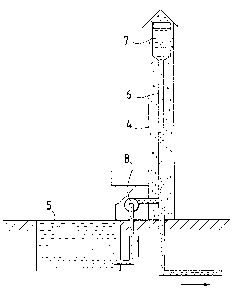Une partie des informations de ce site Web a été fournie par des sources externes. Le gouvernement du Canada n'assume aucune responsabilité concernant la précision, l'actualité ou la fiabilité des informations fournies par les sources externes. Les utilisateurs qui désirent employer cette information devraient consulter directement la source des informations. Le contenu fourni par les sources externes n'est pas assujetti aux exigences sur les langues officielles, la protection des renseignements personnels et l'accessibilité.
L'apparition de différences dans le texte et l'image des Revendications et de l'Abrégé dépend du moment auquel le document est publié. Les textes des Revendications et de l'Abrégé sont affichés :
| (12) Brevet: | (11) CA 1278165 |
|---|---|
| (21) Numéro de la demande: | 1278165 |
| (54) Titre français: | CHATEAU D'EAU |
| (54) Titre anglais: | WATER TOWER |
| Statut: | Périmé et au-delà du délai pour l’annulation |
| (51) Classification internationale des brevets (CIB): |
|
|---|---|
| (72) Inventeurs : |
|
| (73) Titulaires : |
|
| (71) Demandeurs : | |
| (74) Agent: | ROBIC AGENCE PI S.E.C./ROBIC IP AGENCY LP |
| (74) Co-agent: | |
| (45) Délivré: | 1990-12-27 |
| (22) Date de dépôt: | 1986-11-28 |
| Licence disponible: | S.O. |
| Cédé au domaine public: | S.O. |
| (25) Langue des documents déposés: | Anglais |
| Traité de coopération en matière de brevets (PCT): | Non |
|---|
| (30) Données de priorité de la demande: | ||||||
|---|---|---|---|---|---|---|
|
ABSTRACT OF DISCLOSURE
A water tower consisting of a main body extending upward
from the ground, a water channel and a pumping means for
pumping water into the water channel, which acts as a water
storage of the tower. In known water towers, the main water
storage is placed at the top of the tower, at a height of
several tens of meters, which means that the costs of
construction of the tower and its groundwork are consider-
able and impose strict requirements on the structure of the
tower. These problems are solved by the invention in that
the tower is provided with a water reservoir placed at its
lower end under the ground surface or substantially close to
the ground surface, said reservoir constituting a safety
storage of water, and that the water channel of the tower is
of a substantially narrow sectional form through the whole
of its length.
Fig. 2
Note : Les revendications sont présentées dans la langue officielle dans laquelle elles ont été soumises.
Note : Les descriptions sont présentées dans la langue officielle dans laquelle elles ont été soumises.

2024-08-01 : Dans le cadre de la transition vers les Brevets de nouvelle génération (BNG), la base de données sur les brevets canadiens (BDBC) contient désormais un Historique d'événement plus détaillé, qui reproduit le Journal des événements de notre nouvelle solution interne.
Veuillez noter que les événements débutant par « Inactive : » se réfèrent à des événements qui ne sont plus utilisés dans notre nouvelle solution interne.
Pour une meilleure compréhension de l'état de la demande ou brevet qui figure sur cette page, la rubrique Mise en garde , et les descriptions de Brevet , Historique d'événement , Taxes périodiques et Historique des paiements devraient être consultées.
| Description | Date |
|---|---|
| Inactive : Renversement de l'état périmé | 2012-12-05 |
| Le délai pour l'annulation est expiré | 2007-12-27 |
| Lettre envoyée | 2006-12-27 |
| Inactive : CIB de MCD | 2006-03-11 |
| Inactive : TME en retard traitée | 2003-12-08 |
| Accordé par délivrance | 1990-12-27 |
Il n'y a pas d'historique d'abandonnement
| Type de taxes | Anniversaire | Échéance | Date payée |
|---|---|---|---|
| TM (catégorie 1, 7e anniv.) - petite | 1997-12-29 | 1997-12-29 | |
| TM (catégorie 1, 8e anniv.) - petite | 1998-12-29 | 1998-12-29 | |
| TM (catégorie 1, 9e anniv.) - petite | 1999-12-29 | 1999-12-22 | |
| TM (catégorie 1, 10e anniv.) - petite | 2000-12-27 | 2000-11-14 | |
| TM (catégorie 1, 11e anniv.) - petite | 2001-12-27 | 2001-12-12 | |
| TM (catégorie 1, 12e anniv.) - petite | 2002-12-27 | 2002-12-05 | |
| TM (catégorie 1, 13e anniv.) - petite | 2003-12-29 | 2003-12-08 | |
| TM (catégorie 1, 14e anniv.) - petite | 2004-12-27 | 2004-12-03 | |
| TM (catégorie 1, 15e anniv.) - petite | 2005-12-28 | 2005-12-12 |
Les titulaires actuels et antérieures au dossier sont affichés en ordre alphabétique.
| Titulaires actuels au dossier |
|---|
| MIKKO HEIKKI RAIKAMO |
| Titulaires antérieures au dossier |
|---|
| S.O. |